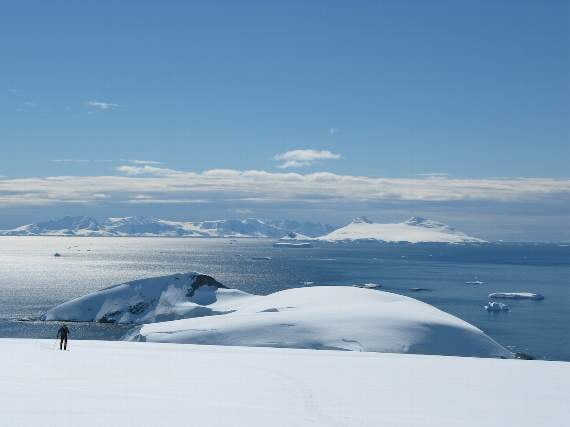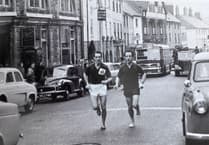WHEN Simon Yates and his climbing buddy Joe Simpson conquered the West face of Siula Grande in the Peruvian Andes, they were breaking new ground.
The 6,356 metre peak had never been scaled before. They had beaten the odds and exceeded their expectations. However, celebration soon turned to tragedy.
Near exhaustion and frost-bite forced the intrepid duo to make a quick descent. A zero-visibility storm made conditions difficult and progress was agonisingly slow...whilst making their way down the North Ridge, disaster struck.
Joe, who was some distance ahead of Simon, stumbled, fell, and broke his leg. Aware beforehand that if anything went wrong on such a hardcore route, a mountain rescue party was unlikely to turn up, Joe thought, “I’m dead.”
Not willing to leave his friend to die a lonely death on the mountain, Simon improvised. Anchoring himself in a snow seat he began to manually lower his crippled companion down the mountain on a 90 metre rope in the fading daylight.
It was a risky business for the both of them, but it was a testament to their mountaineering skills that they managed to descend 3,000ft in both darkness and appalling conditions.
Yet their search for shelter ended badly when Simon inadvertently lowered Joe over an overhang.
With no means to communicate his predicament, or to support his own weight, Joe hung suspended in space.
Not knowing if his climbing partner was alive or dead, Simon dug in deep and took the strain of the rope which connected him to his friend.
For nearly 60 minutes in biting conditions, he held fast, but with every second which passed he felt himself being dragged inch by inch, closer to the void which would kill them both.
On that bitterly cold and desolate mountainside, the 22-year-old relatively inexperienced mountaineer was forced to make a terrible decision that most of us will never have to make.
If he continued to support the strain, both he and Joe would be dragged to a certain death, but if he cut the rope, he would live, but Joe would in all probability die.
With no time to think, and moments to spare, Simon chose life. And life for both Simon and Joe would never be the same again.
In a state of shock and exhaustion, Simon returned to base camp. And three days later, flying in the face of a certain fate, so too did Joe.
With a shattered leg, where the lower bone had forced its way through the kneecap, the injured mountaineer had crawled his way out of the massive crevasse he had fallen into.
Over a course of four days without food and water, Joe had dragged himself back to base camp. He arrived just as a grieving Simon was preparing to leave.
The year was 1985, and news of the pair’s adventure spread like wildfire. Those outside of the climbing community were quick to condemn Simon and praise Joe for his heroics in the face of adversity.
Joe rushed to his fellow mountaineer’s defence and told newspapers at the time, “It’s odd that people imagine I think badly of Simon for cutting the rope.
“There’s a pragmatic side to mountaineering which armchair climbers and the public do not understand. After I landed in the crevasse I did feel angry, but at the circumstances, not with Simon.
“I felt no resentment towards him whatsoever. It would have been totally illogical for Simon to die with me. In fact, because of his decision to cut the rope, we both lived.”
Simon in turn told the press, “I don’t really care what people outside climbing think about the cutting of the rope, because they don’t understand what was involved.
“Sometimes someone who thinks what I did was unacceptable will come up and verbally assault me. The rope between two climbers is symbolic of trust and to cut it is viewed as a selfish act. What’s important is that Joe didn’t think that, and the first thing he did when he crawled back into camp was to thank me for trying to get him down.”
In 2003 the story of their escapades on Siula Grande was back in the public domain when Kevin MacDonald’s documentary ‘Touching the Void’ was released.
Based on Joe Simpson’s book of the same name, the documentary firmly established the tale of Yates and Simpson as one of the most vivid and inspirational pieces of mountaineering lore.
Since escaping near death on that mountain over 30 years ago, the two adventurers have refused to let fear dictate their lives, and continue to do what they do best, climbing!
Simon Yates will be visiting Abergavenny’s Borough Theatre next Wednesday (March 29) to give a talk about that famous incident and a lifetime spent mountaineering.
Ahead of his appearance he swung by the Chronicle for a chat on the Siula Grande incident and why climbing still plays such a massive part of his life.
“I was 22 when I first climbed Siula Grande and although I didn’t feel young at the time, it’s only with hindsight I appreciate just how naive I was and how much I still had to learn both in terms of life and mountaineering,” a 53-year-old Simon told the Chronicle.
“We were both different people then. People ask if the accident marred our friendship, but I don’t believe it did. The reality is if I hadn’t cut the rope we would probably have both died. The fact is we didn’t. We drew a line under it and we’re both here today, which is a happy ending by anyone’s definition. As the old adage goes, ‘what doesn’t kill you makes you stronger.’”
Although the two old friends haven’t seen one another since ‘Touching The Void’ was released, Simpson puts it down to the natural passing of time rather than anything which occurred on Siula Grande.
“Some people might find it strange that we haven’t seen one another in 14 years, but just because we went through such an intense experience together when we were young men doesn’t mean to say we’re going to stay firm friends forever. People drift apart.”
Simon was first bitten by the mountaineering bug at a young age during a school trip to the part of Britain where he now lives, Cumbria.
Simon said, “Growing up in Leicestershire wasn’t a promising start in term of mountaineering but after my first taste of rock climbing in Cumbria I was hooked for life.”
Since that first bite of the cherry, Simon’s addiction to testing his mettle in the most remote, isolated and challenging environments in the world has garnered him a reputation as one of the most accomplished exploratory mountaineers of all time.
From Laila Peak in Pakistan to the Cordillera Darwin in Chile, to Mount Vancouver, Simon’s love for climbing has taken him to the four corners of the globe.
When asked what drives him to keep on keeping on, the answer is very simple.
“More than the challenge and the feeling of accomplishment, mountaineering for me is all about the fundamental reconnection with the natural world,” explained Simon.
“In the modern world we are becoming more and more removed from how we once lived and I feel in an age of smart phones, constant stress and 24-7 information saturation we all need to take some time out to reflect on the bigger picture and recharge our batteries by returning to places and pastimes which remind us of where we’re from.
“Climbing for me is the perfect tonic to any ill. There’s a certain feeling of space and solitude you get on a mountain that’s like nothing else on earth. And the views are pretty amazing too.”
As you can imagine, Simon is a firm believer in getting out in the great outdoors, so the heart can pump, the blood can flow, the lungs can breathe and a person can once again live life the old fashioned way - firsthand! As opposed to through a computerised screen.
The adventurer reflected, “Mountaineering at its essence is no different to other human activities such as gardening or walking the dog. To me they’re all part of the same fundamental need we all share, and that’s to reconnect with nature and return to our roots.”
• Simon Yates will be at the Abergavenny Borough Theatre on Wednesday, March 29, 7.30pm.





Comments
This article has no comments yet. Be the first to leave a comment.